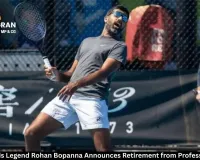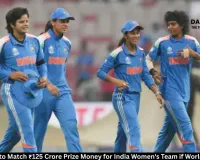Why Rohit Sharma Found Late Success in Cricket?
Digital Desk

Eighteen years after making his international debut, Rohit Sharma finally climbed to the top of the ICC ODI batting rankings, becoming the world’s oldest No. 1 ODI batter at the age of 38. His journey was far from smooth—he struggled for consistency in the early years, took five years to cement his place, and only found his true calling after moving up to open the innings.
Early promise from the Under-19 World Cup
Rohit first made headlines in the 2006 Under-19 World Cup, where India, led by Ravikant Shukla, finished runners-up to Pakistan. The tournament produced future stars like Cheteshwar Pujara, Ravindra Jadeja, and Piyush Chawla. Rohit scored 202 runs with three half-centuries, becoming India’s third-highest run-getter. His consistent domestic performances for Mumbai earned him an ODI debut in 2007, followed by a T20I debut the same year, when he was part of India’s T20 World Cup–winning squad.
In and out of the team for five years
From 2007 to 2012, Rohit’s ODI career remained inconsistent. He batted mostly in the middle order, struggling to deliver impactful performances. During this period, he missed out on major tournaments like the 2009 Champions Trophy and the 2011 ODI World Cup.
By 2012, Rohit had managed around 2,000 runs in 86 ODIs at an average of just 30. Despite flashes of brilliance, he couldn’t translate his talent into match-winning knocks.
The turning point — promoted as opener
Rohit’s career changed dramatically in January 2013, during the home ODI series against England. With Ajinkya Rahane dropped, Rohit was promoted to open in the fourth ODI at Mohali. Chasing 258, he scored a fluent 83 off 93 balls, guiding India to a five-wicket win and sealing the series.
That innings earned him a spot as opener for the 2013 Champions Trophy, where he partnered Shikhar Dhawan. The duo gave India strong starts throughout the tournament, including two century stands, and India went on to lift the title. Rohit’s consistency at the top finally secured his permanent place in the side.
From promise to dominance — three double hundreds
After finding his rhythm as an opener, Rohit reached new heights. In November 2013, he smashed his first double century (209 vs Australia) in Bengaluru, leading India to a series victory. Over the next five years, he added two more double tons (264 in 2014 and 208* in 2017), establishing himself as one of the most destructive limited-overs batsmen in the world.
Between 2013 and 2018, he scored several big innings over 150 runs, including a memorable 171 in Australia*.
2019 World Cup — peak of his batting career
Rohit’s golden run came in the 2019 ODI World Cup, where he hit a record five centuries, finishing as the tournament’s top scorer. He missed converting a fifty into a century only once, showing unmatched consistency at the top. Despite his heroics, India were knocked out in the semi-final.
The wait for No. 1 — overshadowed by Kohli and Babar
Even during his prime, Rohit remained just behind Virat Kohli and later Babar Azam in the rankings. Between 2013 and 2019, he reached a career-best rating of 882 points, but Kohli’s 909-point peak kept him from reaching the top.
When Kohli’s reign ended, Babar took over as No. 1, continuing to block Rohit’s path. Rohit first broke into the top 10 in 2016 and reached No. 2 in 2018 but never crossed the final hurdle—until 2025.
Finally No. 1 at 38
Rohit’s breakthrough came after a stellar performance in the October 2025 ODI series. While Shubman Gill, the then top-ranked batter, struggled across three matches, Rohit scored a fifty and a century, amassing 202 runs in the series. The effort earned him the Player of the Series award and, at last, the No. 1 ODI ranking.
At 38 years and 182 days, he surpassed Sachin Tendulkar’s record (38 years, 73 days) to become the oldest-ever No. 1 ODI batter.
Captaincy at 35 — and ICC glory at last
Just as his batting career peaked late, so did his leadership journey. Rohit became India’s all-format captain in 2022 after Virat Kohli’s exit. Though India fell short in the 2022 T20 World Cup semi-final and the 2023 ODI World Cup final, Rohit’s leadership style brought stability and renewed aggression.
Under his captaincy, India ended their 11-year ICC title drought by winning the 2024 T20 World Cup, beating South Africa by seven runs in the final. He later guided India to the 2025 Champions Trophy and two Asia Cup triumphs.
Better ICC record than Dhoni
While MS Dhoni remains India’s most successful captain in terms of ICC trophies (three titles), Rohit boasts a higher win percentage. India won 83% of their ICC matches (29 out of 35) under him, compared to Dhoni’s 73%.
Late bloom in Tests and eventual retirement
Rohit made his Test debut in 2013, scoring two centuries, but struggled to cement his place until he began opening in 2019. He performed well in England in 2021 but couldn’t sustain the momentum as captain.
After India’s defeats in the 2023 WTC Final, the 2024 home series vs New Zealand, and the 2024–25 Border-Gavaskar Trophy, Rohit’s Test form dipped. He retired from Tests in May 2025 and from T20Is in June 2024, choosing to focus solely on ODIs.
Now, alongside Virat Kohli, Rohit Sharma’s ultimate goal is clear — to lead India to victory in the 2027 ODI World Cup, completing the final chapter of a remarkable late-blooming career











